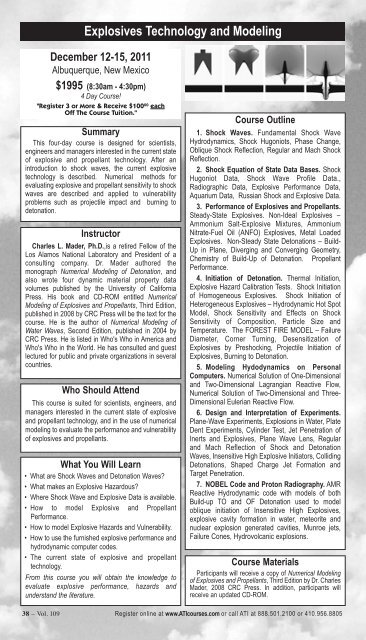Acoustics & Sonar Engineering Radar, Missiles & Defense Systems ...
Acoustics & Sonar Engineering Radar, Missiles & Defense Systems ...
Acoustics & Sonar Engineering Radar, Missiles & Defense Systems ...
You also want an ePaper? Increase the reach of your titles
YUMPU automatically turns print PDFs into web optimized ePapers that Google loves.
Explosives Technology and Modeling<br />
December 12-15, 2011<br />
Albuquerque, New Mexico<br />
$1995 (8:30am - 4:30pm)<br />
4 Day Course!<br />
"Register 3 or More & Receive $100 00 each<br />
Off The Course Tuition."<br />
Summary<br />
This four-day course is designed for scientists,<br />
engineers and managers interested in the current state<br />
of explosive and propellant technology. After an<br />
introduction to shock waves, the current explosive<br />
technology is described. Numerical methods for<br />
evaluating explosive and propellant sensitivity to shock<br />
waves are described and applied to vulnerability<br />
problems such as projectile impact and burning to<br />
detonation.<br />
Instructor<br />
Charles L. Mader, Ph.D.,is a retired Fellow of the<br />
Los Alamos National Laboratory and President of a<br />
consulting company. Dr. Mader authored the<br />
monograph Numerical Modeling of Detonation, and<br />
also wrote four dynamic material property data<br />
volumes published by the University of California<br />
Press. His book and CD-ROM entitled Numerical<br />
Modeling of Explosives and Propellants, Third Edition,<br />
published in 2008 by CRC Press will be the text for the<br />
course. He is the author of Numerical Modeling of<br />
Water Waves, Second Edition, published in 2004 by<br />
CRC Press. He is listed in Who's Who in America and<br />
Who's Who in the World. He has consulted and guest<br />
lectured for public and private organizations in several<br />
countries.<br />
Who Should Attend<br />
This course is suited for scientists, engineers, and<br />
managers interested in the current state of explosive<br />
and propellant technology, and in the use of numerical<br />
modeling to evaluate the performance and vulnerability<br />
of explosives and propellants.<br />
What You Will Learn<br />
• What are Shock Waves and Detonation Waves?<br />
• What makes an Explosive Hazardous?<br />
• Where Shock Wave and Explosive Data is available.<br />
• How to model Explosive and Propellant<br />
Performance.<br />
• How to model Explosive Hazards and Vulnerability.<br />
• How to use the furnished explosive performance and<br />
hydrodynamic computer codes.<br />
• The current state of explosive and propellant<br />
technology.<br />
From this course you will obtain the knowledge to<br />
evaluate explosive performance, hazards and<br />
understand the literature.<br />
Course Outline<br />
1. Shock Waves. Fundamental Shock Wave<br />
Hydrodynamics, Shock Hugoniots, Phase Change,<br />
Oblique Shock Reflection, Regular and Mach Shock<br />
Reflection.<br />
2. Shock Equation of State Data Bases. Shock<br />
Hugoniot Data, Shock Wave Profile Data.,<br />
Radiographic Data, Explosive Performance Data,<br />
Aquarium Data, Russian Shock and Explosive Data.<br />
3. Performance of Explosives and Propellants.<br />
Steady-State Explosives. Non-Ideal Explosives –<br />
Ammonium Salt-Explosive Mixtures, Ammonium<br />
Nitrate-Fuel Oil (ANFO) Explosives, Metal Loaded<br />
Explosives. Non-Steady State Detonations – Build-<br />
Up in Plane, Diverging and Converging Geometry,<br />
Chemistry of Build-Up of Detonation. Propellant<br />
Performance.<br />
4. Initiation of Detonation. Thermal Initiation,<br />
Explosive Hazard Calibration Tests. Shock Initiation<br />
of Homogeneous Explosives. Shock Initiation of<br />
Heterogeneous Explosives – Hydrodynamic Hot Spot<br />
Model, Shock Sensitivity and Effects on Shock<br />
Sensitivity of Composition, Particle Size and<br />
Temperature. The FOREST FIRE MODEL – Failure<br />
Diameter, Corner Turning, Desensitization of<br />
Explosives by Preshocking, Projectile Initiation of<br />
Explosives, Burning to Detonation.<br />
5. Modeling Hydodynamics on Personal<br />
Computers. Numerical Solution of One-Dimensional<br />
and Two-Dimensional Lagrangian Reactive Flow,<br />
Numerical Solution of Two-Dimensional and Three-<br />
Dimensional Eulerian Reactive Flow.<br />
6. Design and Interpretation of Experiments.<br />
Plane-Wave Experiments, Explosions in Water, Plate<br />
Dent Experiments, Cylinder Test, Jet Penetration of<br />
Inerts and Explosives, Plane Wave Lens, Regular<br />
and Mach Reflection of Shock and Detonation<br />
Waves, Insensitive High Explosive Initiators, Colliding<br />
Detonations, Shaped Charge Jet Formation and<br />
Target Penetration.<br />
7. NOBEL Code and Proton Radiography. AMR<br />
Reactive Hydrodynamic code with models of both<br />
Build-up TO and OF Detonation used to model<br />
oblique initiation of Insensitive High Explosives,<br />
explosive cavity formation in water, meteorite and<br />
nuclear explosion generated cavities, Munroe jets,<br />
Failure Cones, Hydrovolcanic explosions.<br />
Course Materials<br />
Participants will receive a copy of Numerical Modeling<br />
of Explosives and Propellants, Third Edition by Dr. Charles<br />
Mader, 2008 CRC Press. In addition, participants will<br />
receive an updated CD-ROM.<br />
38 – Vol. 109 Register online at www.ATIcourses.com or call ATI at 888.501.2100 or 410.956.8805

















